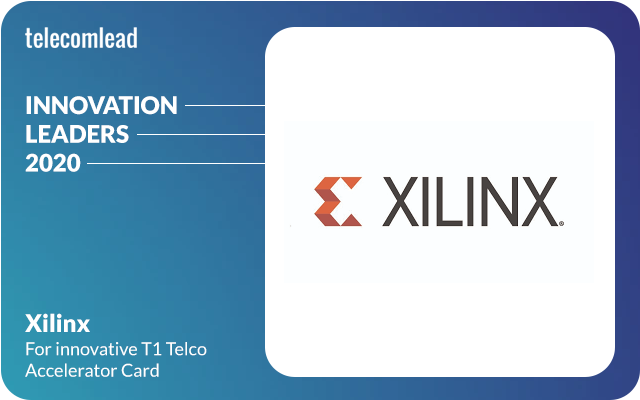Xilinx is one of the winners of TelecomLead.com Innovation Leaders 2020 for the innovative T1 Telco Accelerator Card that supports O-RAN and virtualization.
 Xilinx recently launched T1 Telco Accelerator Card for O-RAN distributed units (O-DUs) and virtual baseband units (vBBUs) in 5G networks.
Xilinx recently launched T1 Telco Accelerator Card for O-RAN distributed units (O-DUs) and virtual baseband units (vBBUs) in 5G networks.
The innovative T1 card is available. Xilinx is sampling T1 card to customers. Xilinx will start the volume production of T1 card in 2021.
Dimitris Mavrakis, senior research director at tech market advisory firm, ABI Research, said earlier that the Xilinx T1 card announcement is a major breakthrough and a significant milestone in the evolution of Open RAN, a market expected to be worth US$37.5 billion in 2025 and approximately 22 percent of the total public network RAN market.
The plug-and-play ability of T1, using an industry-standard PCIe card form factor, together with a targeted design for handling complex, time-sensitive, and high-volume L1 functions of 5G radio will simplify the complexity of Open RAN equipment and accelerate its implementation across multiple deployment scenarios.
The T1 card, a multi-function PCIe form factor card, performs both O-RAN fronthaul protocols and layer 1 offload. The offload capabilities enable T1 card to cut the number of CPU cores required in a system. The T1 card enables the O-DU to improve 5G performance and services while cutting system power consumption and cost compared to competitive offerings.
Telecom engineers can plug the T1 card into standard x86 or non-x86 servers to achieve the real-time protocol processing performance required for 5G virtualized O-DU platforms. It offloads line-rate and compute-intensive functions including: channel encoding/decoding using hardened LDPC and Turbo codecs, rate matching/de-matching, HARQ buffer management, and more, freeing the processor cores for running other services.
The T1 card simplifies 5G deployments by offering a turnkey solution through ecosystem partners that includes both O-RAN fronthaul and 5G NR layer 1 reference designs, as well as pre-validated software to enable operators, system integrators, and OEMs to get to market quickly.
The offloading of channel coding functions from the CPU to the T1 card delivers up to 45x encoding and 23x decoding throughput improvement relative to the same server without acceleration. The T1 card enables the use of fewer CPU cores, driving down system cost and overall power consumption.
It can process multiple sectors of 5G NR 4TRX at 100 MHz OBW with its 50 Gbps of optical ports for O-RAN fronthaul termination. The Fronthaul and L1 bandwidths are matched for optimal scalability; the more towers you want, the more cards you add to the server.
Dan Mansur, vice president of marketing, Wired and Wireless Group, Xilinx, said: “Working with our ecosystem partners, Xilinx hardware, IP and software are leading the innovation and realization of 5G O-RAN networks.”
Winners of the TelecomLead.com Innovation Awards 2020 were selected by a group of technology journalists, analysts and telecom industry veterans. We are not disclosing their names since some of them have NDA-related issues.





